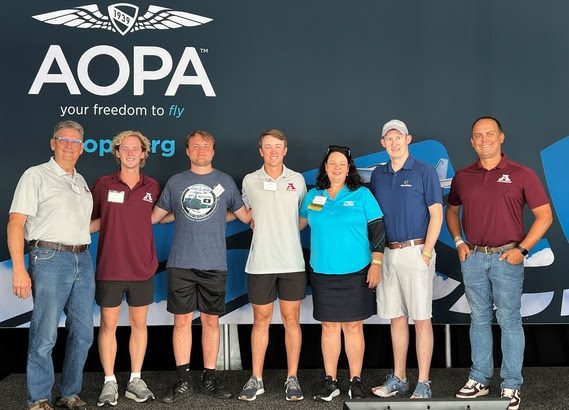Photo above – Left to Right, Bill Holland, David Anderson, Zane Hudspeth, John David Muse, Elizabeth Tennyson, Grayson Ardies, Chris Eckler.
Nestled between Milwaukee and Green Bay, lies Wittman Regional Airport in Oshkosh, Wisconsin, host of the annual EAA AirVenture, which brings together members and aviation enthusiasts totaling more than 600,000 people. Organizers announced that they tied a record with people from 93 different countries on hand for the event for the annual airshow and convention.
The Oklahoma Department of Commerce and Oklahoma Aeronautics Commission led a delegation of communities to exhibit at the show including the Ada Jobs Foundation, Ardmore Development Authority, Bartlesville Development Authority, the City of McAlester, and Tulsa International Airport.
It was a busy week for keeping track of all the planes in the air with about 19,000 aircraft movements at the Wittman Airport. EAA CEO and Chairman Jack Pelton stated that over 3,300 show planes, more than 1,400 vintage aircraft, 1,000 home builds, 380 war birds, 194 ultra lights, 65 C-planes, and 52 Aerobatic aircraft were part of the tapestry of planes on the field. More than 74,000 people camped under aircraft or in RVs during the week-long event.
Hundreds of Oklahomans posted their pilgrimage on social media as they made their way to the annual event that is in its 71st year. Among those fervent pilots that braved sweltering heat, severe thunderstorms, and primitive camping conditions were three students from Ada High School in Ada, Oklahoma. The young aviators were selected to speak at an AOPA breakfast on Thursday morning to tell their aviation story and to express their thanks to the donors and veteran pilots who donate to the “You Can Fly” program.
What began in 2017 as a field test opportunity, for the newly developed AOPA you can fly high school aviation curriculum has resulted in over 80+ schools teaching the program in the fall of the 2023-2024 school year.
“Watching these young men tell their Oklahoma aviation story to a crowd of pilots from across the United States brought the hard work of our Commission staff over the past four years into full focus. Oklahoma public education is making pilots, and that is pretty incredible,” said State Director of Aeronautics Grayson Ardies. “Students are leaving these high school programs prepared to enter post-secondary aviation programs and ultimately, into the aerospace workforce. I think I can speak for AOPA in saying that the curriculum is doing exactly what it was designed to do, which is to meet a critical need to address not only the pilot shortage but an overarching aerospace tone.”
David Anderson from Ada, Oklahoma graduated from Ada High School in 2021, and just completed his second year at Oklahoma State University in the Part 141 program at OSU. He has his private pilot license.
“I truly believe that the AOPA “You Can Fly” High School Aviation Curriculum has changed the way Oklahoma schools view STEM education. The curriculum provides students with a pathway of learning that has been designed to ensure that students are ready for post-secondary aerospace careers. In many cases, the curriculum has changed the trajectory of these students’ lives,” said Paula Kedy, the Aerospace and Aviation Education Coordinator for the Oklahoma Aeronautics Commission. “The curriculum is offered free to schools, and our Oklahoma schools are using it to build extraordinary aviation programs.”
John David Muse, a student at Southeastern University, will enter his sophomore year in their aviation program. He completed all four years of the AOPA program at Ada High School while also balancing his outstanding achievements in athletics and baseball.
Zane Hudspeth has several hours toward his pilot license and has an interest in rotor and fixed-wing aircraft. He is currently working with Oklahoma National Guard recruiters to enter into military service with an aviation and pilot focus.
“I think that the students from Ada High School that spoke to the impact that the AOPA curriculum has had on their career choices are representative of thousands of students across the country that are benefitting from the AOPA “You Can Fly” High School Aviation Curriculum,” said Kedy.
To explore pilot training and for more information about the Oklahoma Aeronautics Commission and its programs, visit https://oklahoma.gov/aerospace.



